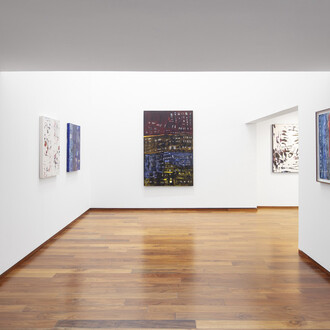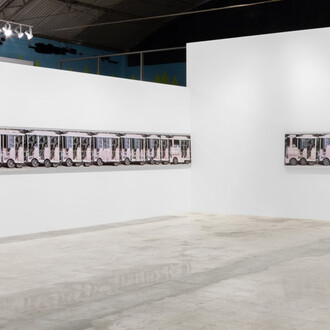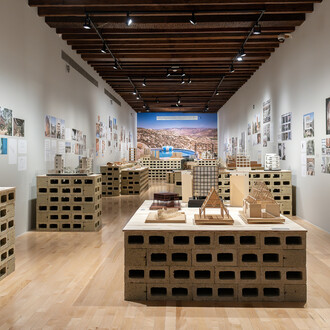Claudia Pagès Rabal confronts the processes, relationships, and foundational narratives of hegemonic structures through a wide artistic practice, with works that include video, sculpture, text, performance, and installation. In this exhibition, the pieces conform a fragmented map where the geographical, political, and linguistic intertwine in the landscape of Montjuïc—the mountain of the gerund, as the artist conceives it: a place where the clock loses its hands, allowing life, death, and all the tensions imposed by the system between these two states to coexist.
Walking the Gerund Mountain (Montjuïc bando port) is a video installation that documents the artist’s walks through Montjuïc, the mountain that overlooks the port of Barcelona. At first glance, the work appears robust and almost imperturbable; however, its discursive complexity is mirrored in its material construction: a series of fragile LED panels, magnetized and delicately superimposed onto a metal structure that conceals a chaotic tangle of cables. The fragmented images on each screen show Pagès walking through various sites on the hill—spaces marked by economic disparity and contradictions, where solemn landmarks, tourist viewpoints, and invasive plant life coexist. In doing so, the work reveals how the mountain holds multiple layers of concealed and impenetrable interweavings of power, violence, resistance, and memory.
Throughout the exhibition, the concept of the gerund reappears. This time, it is not about the temporal loop evident in the video, but rather the traces left by the artist’s gestures on tracing paper. Pagès Rabal constructs a universe where every sign and gesture leaves a mark—this time, through the negative. The carbon paper requires the interaction of light in Boundaries mur, canya invasora, and El port fa nino-nino to reveal that in the absences of carbon on the paper, there are silhouettes of mirrored words, of walls, of reeds, and of the mountain’s flora.
Each trace offer ways of understanding how we inhabit spaces, how we name them, and how those names, in turn, articulate us. The port, the mountain, the walls, and the invasive plants are not mere studies of the landscape; they are bodies in tension, crossed by violence and historically contradictory structures, and by echoes of warfare that are perceived in interstitial spaces and in backlight. Thus, these works do not represent the territory per se, but speak of the gerund as a continuous action—as if the territorial and the identitary were condemned to a perpetual, impersonal progression that ultimately upholds the status quo.
In response to this conceptual paradox arises Fugues gerund (Agua salada), a work also made with carbon paper on aluminum. Here, under the presence of LED light, the composition becomes a manual of escape—not only from the gerund as a verb tense and from its agent as a promoter of structural hegemony. Each fragment of text and image proposes as an attempt, a possible exit, exploring alternative forms of understanding through nonlinear and queer temporalities.
Claudia Pagès Rabal moves between language and place, allowing words to erode the rigid edges of both geographic and symbolic maps. Rather than closing off meaning, her works open it inviting the viewer to read space as an echo, bouncing back and forth between the past and the never-ending now.
(Text by Valeria Flores López-Araiza)
















